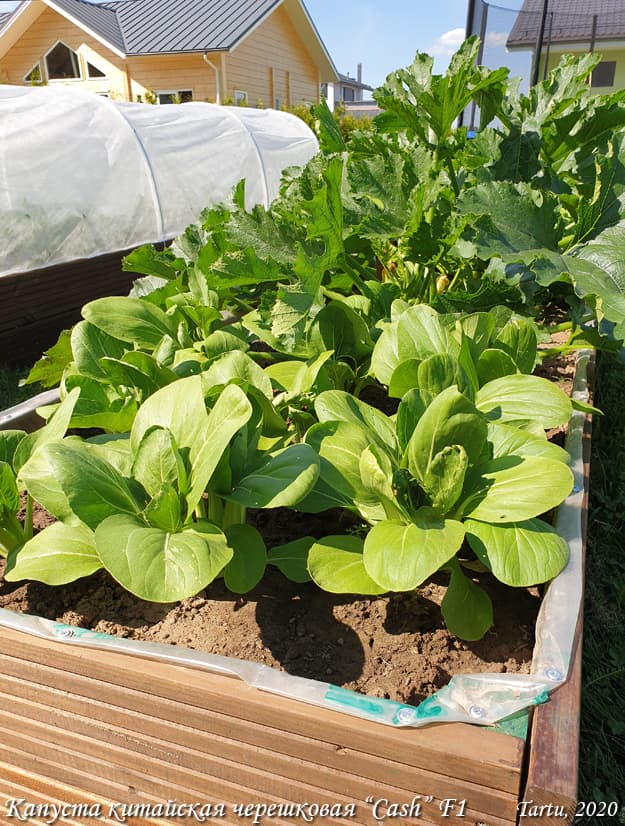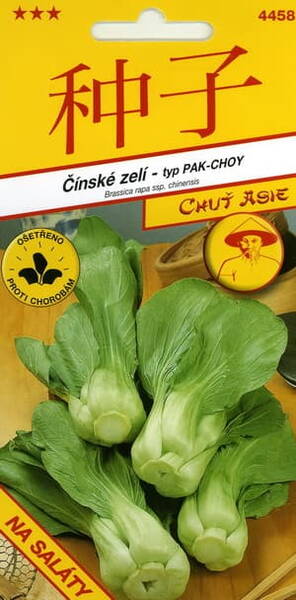Ex Tax: 64.55€
Leaf vegetable for vegetable salads, frying and drying as well. For autumn growing. Vegetation period 45 days.
The stalks are cooked and eaten like asparagus. The green parts of the leaves can be stewed like spinach.
Rosette of leaves with a diameter of 20-40 cm. Productivity - up to 16-18 kg/m2 in the protected ground and up to 4-5 kg/m2 in open ground.
Features of agricultural technology: for open ground and film shelters.
Chinese cabbage can be grown as an early summer and autumn crop.
Chinese cabbage does not tolerate transplanting, so most often it is grown by sowing seeds in the ground in a permanent place.
Sowing begins at the end of April.
1 gram = 300-350 seeds.
Planting pattern: 30-40 cm x 15-20 cm.
Ripening terms: early ripening - leaves can be harvested 40-50 days after sowing seeds and 25 days after planting seedlings.
Fetus. A characteristic feature of this cabbage is a wide petiole at the base of a whole leaf of an obovate shape.
The diameter of the rosette of leaves is 20-40 cm. It does not form a head.
Stability: cold-resistant, little affected by diseases.
Use: salad.

Agrotechnics: cultivation of stalked pak choi is similar to the cultivation of leafy Chinese cabbage.
Kale also has much less stringent soil requirements than cabbages or cauliflowers.
Normal garden medium fertilized soil is suitable. In autumn, the soil is limed (if necessary) and manure or compost is applied in the amount of 4-5 kg / m2 and dug up.
It is even better to use mature compost or humus. It is applied in the spring in the amount of 5-8 l / sq. meter.
They are sprinkled with rows of seeds or seedlings and mixed a little with the ground. You can use mineral fertilizers.
In the spring, 10-15 g of ammonium nitrate, 15-20 g of potash fertilizers, 15-20 g of double superphosphate, or the corresponding amount of complex fertilizer are applied per 1 m2 in spring.
It is good to replace part of potash fertilizers with ash 100 g (one glass).
Pak-choi is usually sown in early July (mid-summer). This is the most favorable time than sowing in early spring.
Sow immediately on the beds in the grooves to a depth of 3-4 cm. Then the seedlings are thinned out. The interval between rows is 35 cm, in the row between plants 30 cm.
Early spring sowing in pots is also possible, then planting on the beds. You can not sow plants in freshly dug up soil. Loose earth should be somewhat compacted.
Care and feeding.
Like all cabbage plants, pak choi is demanding on regular good watering. It is required to regularly weed weeds and loosen the soil.
During the growing season, pak-choi should be fed 1-2 times with liquid herbal fertilizer or mullein infusion. It is also advisable to fertilize after prolonged rains.
Harvesting. Pak-choi summer crops are harvested in September before frost.
Prevention of diseases and pests is the same as other types of cabbage.
Return to the old place after 3-4 years.
Eng.: Chinese cabbage (Pak-choy). Bot. syn.: Brassica antiquorum H.Lev., Brassica campestris subsp. chinensis (L.) Makino, Brassica campestris var. chinensis (L.) T.Ito, Brassica chinensis L., Brassica dubiosa L.H.Bailey, Brassica oleracea var. chinensis (L.) Prain, Brassica rapa var. amplexicaulis Y.Tanaka et Ono, Brassica rapa var. chinensis (L.) Kitam.
Please note that... in terms of nutritional value, Chinese cabbage is close to white cabbage.
Very early ripening, cold-resistant, therefore it is possible to obtain an early harvest of vitamin products.
Chinese cabbage is unpretentious and simple in agricultural technology, it can be grown by sowing seeds in open ground.
Unlike other leafy cabbages, it is less damaged by diseases, which makes it possible to get a high yield.
Juicy Chinese cabbage leaves make excellent salads and side dishes.
Did you know that... despite the fact that Chinese cabbage is similar in nutritional value to white cabbage, it contains 3 times more vitamin C than white cabbage.
It has the ability to dissolve foreign proteins that enter the bloodstream, therefore it serves as a cleaner from harmful microorganisms.
A close relative of Chinese cabbage, Peking cabbage, is no less useful, since it surpasses not only white cabbage, but also Chinese cabbage in the content of vitamins and proteins.












